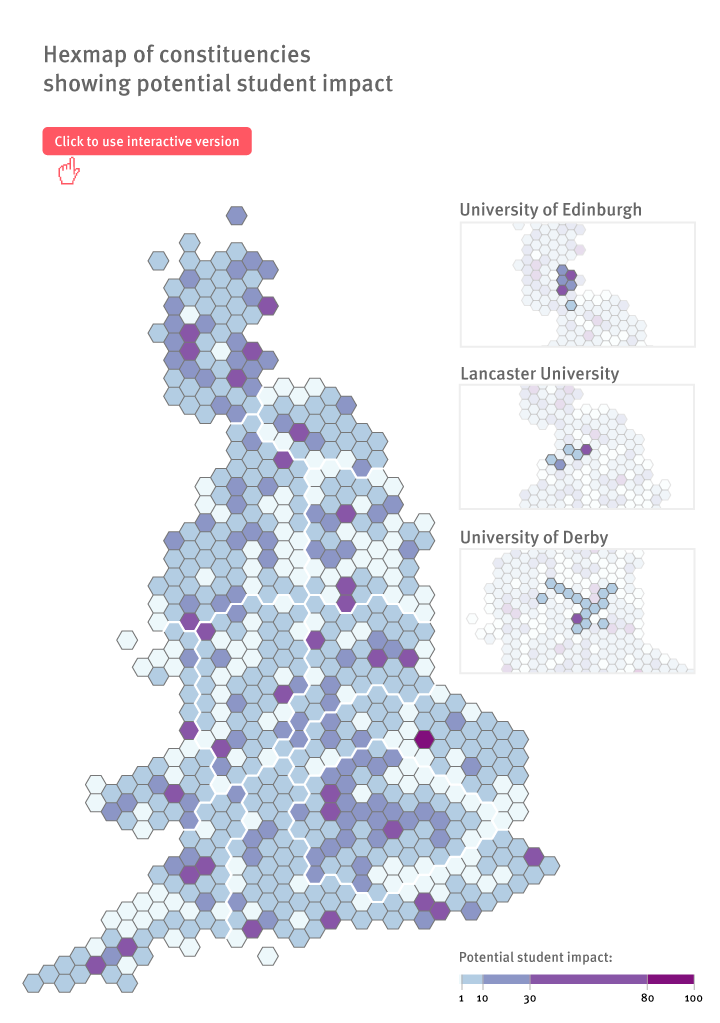
The UK’s snap general election has given universities and student organisations a very short amount of time to get their message across to students ensuring they are registered to vote.
However, a new data analysis by Times Higher Education reveals just how important those voters could be, especially in crucial battleground seats where the Conservatives are looking to strengthen their parliamentary majority by taking Labour-held constituencies.
Marrying census statistics on the number of students in constituencies with data on each university’s own student population (see here for full methodology), the analysis pinpoints exactly which universities could have the biggest influence on results in terms of the votes of their students.
Universities that score highly (see table below) – owing to their campuses having a large share of students in nearby constituencies that had close results in the 2015 general election – include the University of Cambridge (where Labour narrowly beat the Liberal Democrats last time), Lancaster University (close to the ultra-marginal Labour seat of Lancaster and Fleetwood) and the University of Edinburgh (close to seats where the Scottish National Party, Labour and Liberal Democrats all have a reasonable chance of winning).
Source: Times Higher Education data scientists
For students to sway a constituency result, a number of conditions need to be met, not least that enough vote at their term-time address. The general election will be held at a time when many students will have finished exams and be drifting away from campus. A poll commissioned by the Higher Education Policy Institute earlier this month showed that only 25 per cent of students planned to vote in their “university constituency” rather than their “home address”.
However, the National Union of Students campaign to get students registered by the 22 May deadline has been reminding them that they can be registered at both a term-time and home address, and choose to vote in one of the two.
Rob Young, NUS vice-president for society and citizenship, said it was important that students were aware of all their options, which could also include voting by post from home but for their university seat.
He added that the NUS would also “support [local] student unions and let them know about the constituencies where the margins are quite small”.
Nick Hillman, director of Hepi and a former Conservative general election candidate, said it would be “totally legitimate” if students choose to vote in their term-time constituency, or likewise their home seat, due there being a higher probability they could impact the result.
“You are just playing by the rules of a first past the post electoral system. It is a bit like tactical voting. Nobody would ever think it appropriate to ban tactical voting,” he said.
But he warned that the likelihood of students doing this assumed they had a keen enough interest in politics to know how marginal constituencies actually were.
“You have to be as obsessed with politics as I am to think about your vote at that depth,” said Mr Hillman. “The best way to do it is to organise a postal vote in one of the two seats but that takes a lot of organisation that people can’t always be bothered with,” he added.
Work in UK higher education? Take our two-minute general election survey
THE’s analysis – devised by World University Rankings data scientist Emma Deraze – could help give students such information. It includes satellite campuses to show that some institutions’ students might have a say across a wide geographical area.
A key example is the top-scoring institution – the University of Derby – which has students spread across three campuses, two of them outside Derby. The city itself is split between Derby North, a very narrow Tory win in 2015, and Labour-held Derby South, which the Tories are sure to target this time.
According to Stephen Fisher, associate professor in political sociology at the University of Oxford and co-author of a Hepi report before the last election on student voting patterns, the seats where students may have the most impact would most likely be those further down the Tory target list where students could “save them” for Labour.
This would assume that Hepi’s poll this month showing 55 per cent student support for Labour does translate into more votes for the party in student areas.
But Professor Fisher said, given this, “seats that are in the balance and where students might be most effective" included places like Exeter (the University of Exeter comes 19th on THE’s list), Nottingham South (both Nottingham universities are in the top half of the list), York Central and Norwich South. Derby South, mentioned above, might also fit into this category. Professor Fisher also highlighted the potential importance of students in Edinburgh’s constituencies.
He added that his previous research had shown that in student areas there can be a higher, but small, swing towards a particular party than the national average, although in reality this rarely changed the result. For instance, anger over the Lib Dems breaking their tuition fees pledge may have led to a fall in the party’s vote of two percentage points above the average in student areas and their losing the Cambridge constituency to Labour.
A two-point extra slant towards Labour this time in some student areas on the Tory target list “might be enough" to help the party “hold on to a handful” of seats, he said.
Mr Hillman added that academics’ voting intentions should also be thrown into this mix. “University constituencies include a lot of university staff,” he pointed out, “...and we know, not least from polls [carried out by THE], that academics tend to vote more left-wing than the rest of the country”.
As for the issues that may be important for students on 8 June, the obvious candidate would be tuition fees and Labour’s pledge to scrap them. But Mr Hillman warned that students were often just as likely to be interested in issues affecting the wider population, like Brexit.
Mr Young also made a similar point, saying that in his view Brexit, and the damage he said it would potentially do to students’ futures, was higher up on their list of concerns.
“I think students do want to see a fairer funding system [for higher education]...but I think when students go to the ballot box [Brexit] is the thing that they will think most about.”


















Have your say